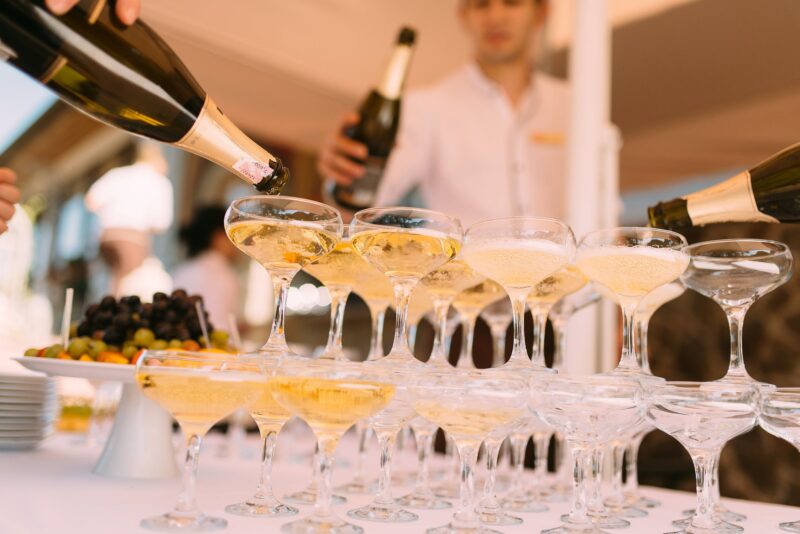When you think of champagne, you probably imagine toasts and celebrations, and that’s exactly what your wedding day embodies. But with so many options and details to consider, where do you start? That’s where this guide comes in.
From selecting the right type of champagne to fit your wedding style and budget, to tips on serving it at the perfect temperature, we’ve got you covered.
How to Choose the Perfect Champagne?
Selecting the right beverage for your wedding is a decision that requires thoughtful consideration. Here are some key factors to keep in mind:
Know Your Budget
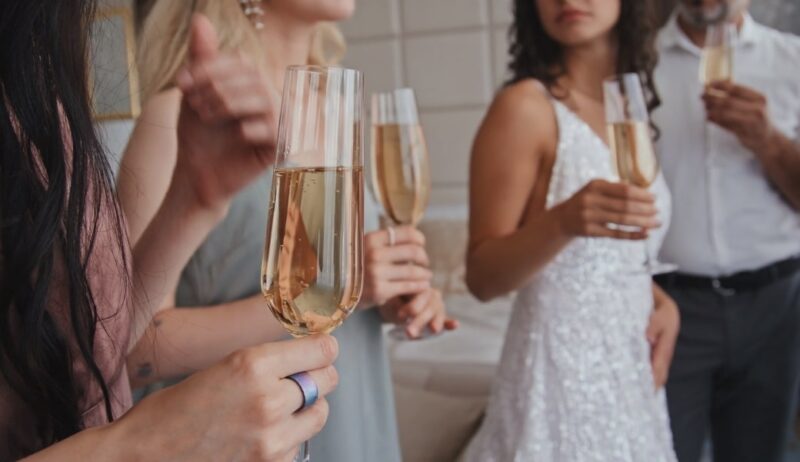
First and foremost, it’s essential to establish a budget. Champagne prices can vary widely, and having a clear budget in mind will help you narrow down your options. Whether you’re looking for a top-tier beverage or a more budget-friendly option, there’s a bottle for every price range.
Determine Your Style
Champagne comes in a range of styles, from bone-dry brut to semi-sweet demi-sec. Your personal taste and the preferences of your guests should guide your choice. For example, Brut, which strikes a balance between dryness and sweetness, is a popular choice for weddings, as it caters to a wide range of palates.
Research Different Brands
Champagne is produced by various renowned houses, each with its unique characteristics and history. Take the time to research and explore different champagne brands.
Read reviews and seek recommendations from wine experts to find a beverage that not only aligns with your taste but also fits within your budget. Some well-known brands include Dom Pérignon, Moët & Chandon, and Veuve Clicquot.
Calculate the Quantity
Estimating the quantity of champagne you’ll need is essential to avoid running out or over-purchasing. A general guideline is to plan for one glass per guest for the traditional toast. If you plan to serve it throughout the event, consider two glasses per guest.
Keep in mind that a standard champagne bottle contains approximately six glasses, and it’s better to have a little extra than to run out during the festivities.
Storing the Beverage
Proper storage of champagne is crucial to ensure it maintains its freshness and flavor until the moment it’s poured. Follow these guidelines:
- Maintain a Consistent Temperature: Champagne should be stored at a consistent temperature of around 55°F (13°C). Fluctuations in temperature can negatively impact the wine’s quality. Avoid storing it in the refrigerator for an extended period, as the temperature variations in a typical fridge can harm the beverage.
- Store Bottles Horizontally: Lay your bottles horizontally in a wine rack or a specialized rack. This position keeps the cork moist, preventing it from drying out, which can lead to leaks and spoilage. Horizontal storage also helps the champagne age gracefully.
- Keep Champagne Away from Light: This beverage is sensitive to light, particularly UV rays, which can cause it to age prematurely and develop unpleasant flavors. Store your bottles in a dark, cool place, away from direct sunlight. If possible, use tinted or opaque storage containers to further protect your beverage from light exposure.
- Handle Bottles Gently: Champagne is a delicate wine, and rough handling can result in unwanted fizzy surprises when you open the bottle. When moving or transporting the bottles, do so gently and avoid any sudden jolts or vibrations.
Serving Champagne with Elegance
Once you’ve chosen the perfect champagne and ensured it’s stored correctly, it’s time to master the art of serving champagne with grace and style at your wedding. Here are the essential steps to achieve a flawless service:
1. Chilling the Champagne
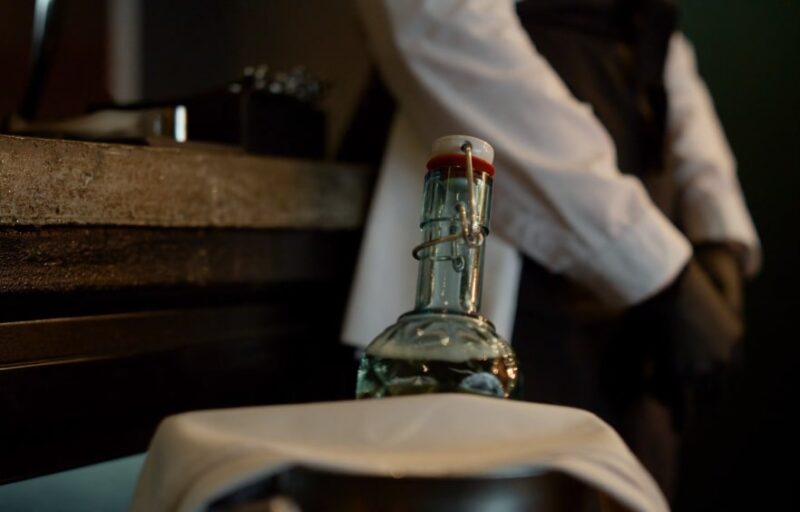
Before serving, it’s crucial to ensure that your champagne is at the ideal temperature. Approximately 30 minutes before the celebration, place the bottles in a bucket filled with ice and water.
Avoid using a freezer, as it can cause the wine to freeze and expand, potentially leading to cork ejection.
2. Opening the Bottle
Opening a champagne bottle can be both exciting and intimidating. To do it with finesse, follow these steps:
- Start by removing the foil covering the cork, revealing the wire cage beneath.
- Hold the bottle at a 45-degree angle, ensuring it’s away from people and fragile objects.
- Firmly grasp the cork with one hand while holding the base of the bottle with the other.
- Slowly and steadily twist the bottle, not the cork, while maintaining gentle pressure on the cork.
- As the cork loosens, you’ll hear a subtle sigh and a soft pop, indicating the beverage is ready to be poured.
3. Choosing the Right Glassware
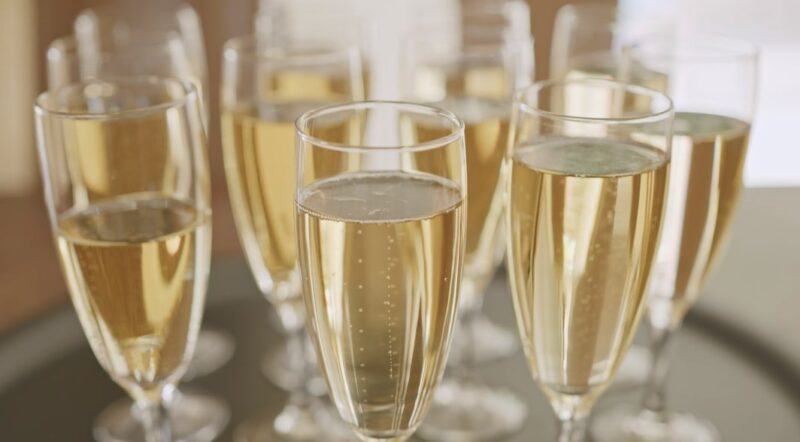
Selecting the appropriate glassware can significantly enhance the whole experience for you and your guests. The two most common options are flute glasses and tulip-shaped glasses:
| Glass Type | Description | Advantages |
|---|---|---|
| Flute Glasses |
|
|
| Tulip-Shaped Glasses |
|
|
Whichever style you choose, make sure the glasses are clean and free of any residues, as even the slightest impurities can affect the bubbles and taste of the champagne.
4. Pouring Champagne
The way you pour champagne can affect both its presentation and taste. Here’s how to pour it like a pro:
- Hold the glass at a slight angle, aiming to pour the champagne down the inside edge of the glass. This technique minimizes excessive foaming.
- Pour it gently, allowing it to glide smoothly into the glass. Avoid a rapid or aggressive pour to prevent overflow.
- Fill each glass to about two-thirds full, leaving enough room for the wine to breathe and the bubbles to rise. Overfilling can cause spillage and detract from the elegance of the service.
5. The Perfect Toast
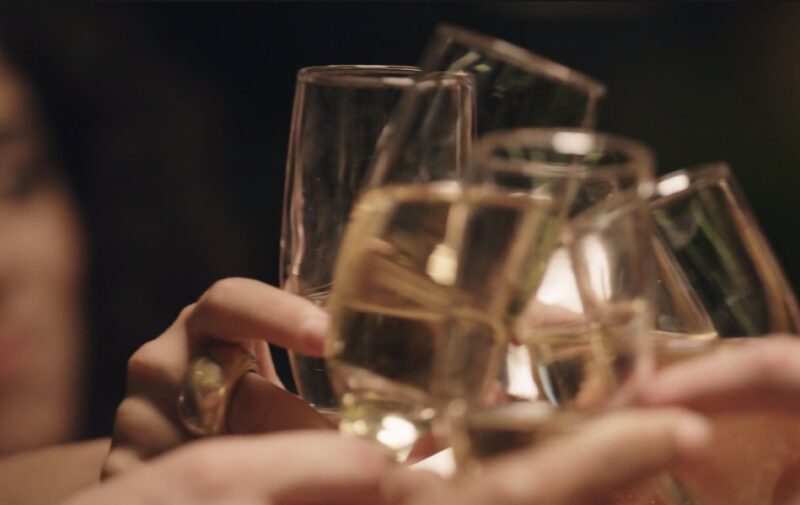
The toast is a cherished moment at weddings, and it’s an opportunity to express your gratitude and celebrate with your loved ones. Encourage your guests to raise their glasses and join in the celebration.
Prepare a heartfelt toast that reflects your joy and appreciation for your guests’ presence. Clink glasses gently with those around you to avoid accidents and ensure a harmonious and joyful toast.
What About Pairings?
Selecting the right food pairings to accompany your beverage can elevate the overall dining experience at your wedding.
Appetizers and Canapés
Oysters: Oysters are a classic and luxurious pairing with champagne. Their briny and fresh flavors harmonize beautifully with the wine’s acidity and effervescence.
Caviar: For an indulgent touch, consider pairing the beverage with caviar. The delicate and salty notes of caviar complement the wine’s finesse.
Mini Quiches: These savory pastries are a delightful option to pair with champagne, offering a contrast in textures and flavors.
Main Course
Chicken: Champagne’s crisp acidity pairs wonderfully with chicken dishes, whether they’re roasted, grilled, or served in a creamy sauce.
Seafood: Champagne’s freshness and lightness make it an excellent match for seafood, such as lobster or scallops, highlighting the delicate flavors of the ocean.
Vegetarian Options: If you have vegetarian guests, consider pairings for dishes like mushroom risotto or grilled vegetables.
Desserts
Fruit Tarts: The fruity notes in champagne make it a delightful companion for fruit tarts or desserts featuring fresh fruits.
Shortcake: Champagne’s effervescence can cut through the sweetness of shortcake, creating a harmonious pairing.
Chocolate: If you have a penchant for chocolate desserts, consider a demi-sec champagne for a sweeter contrast that complements the richness of chocolate.
Cheese
Brie: Creamy and mild, Brie cheese pairs delightfully with this beverage, enhancing the wine’s buttery notes.
Goat Cheese: The acidity of champagne balances the tangy flavors of goat cheese, creating a balanced and flavorful combination.
Gruyère: For a heartier option, pair champagne with Gruyère cheese, known for its nutty and slightly sweet taste. When planning your wedding menu, collaborate with your caterer or sommelier to create a cohesive and harmonious dining experience. Offering a variety of pairings can cater to different tastes and preferences among your guests.
Exploring Alternatives – Sparkling Wine Options
While champagne is the most famous sparkling wine, there are excellent alternatives that can cater to various budgets and palates. Here are some sparkling wine options to consider:
| Sparkling Wine | Origin | Characteristics | Suitable Occasions |
|---|---|---|---|
| Prosecco | Italy | Light and fruity profile, budget-friendly, pleasant effervescence | Casual and outdoor weddings |
| Cava | Spain | Crisp and refreshing, notes of apple and citrus, exceptional value | Versatile for various events |
| Crémant | France (outside Champagne) | Quality and diversity, lower price point than traditional champagne | Formal and celebratory events |
| American Sparkling Wine | United States (especially California) | Various styles, from dry to sweet, supports local wineries | Customizable to preferences |
Exploring these alternative sparkling wine options can add a unique and personal touch to your celebration, allowing you to select a wine that resonates with your preferences and budget.
Champagne Etiquette
To ensure that your champagne service at your wedding is both elegant and seamless, it’s essential to adhere to proper champagne etiquette. Here are some essential etiquette guidelines to follow:
Toasting Order
Traditionally, the bride and groom make the first toast, followed by the best man and maid of honor. Other guests may then offer toasts. It’s important to acknowledge each toast with gratitude, expressing your appreciation for your guests’ well-wishes.
Coordinate with your photographer and master of ceremonies to capture the toast at the perfect moment. Traditionally, the toast takes place after the main course and before dessert. This timing ensures that all guests are present and can participate in the celebration.
Refills
During the reception, keep a watchful eye on your guests’ glasses and ensure they are topped up if desired. This task can be delegated to your waitstaff or bartender to ensure a continuous flow of champagne throughout the celebration.
Non-Alcoholic Options
It’s important to remember that not all guests may consume alcohol. To accommodate everyone, provide non-alcoholic sparkling options such as sparkling cider or alcohol-free champagne for those who prefer them.
Ensuring inclusivity for all your guests is a thoughtful and considerate touch.
FAQs
Can I store champagne in the refrigerator until the wedding?
While it’s okay to chill it in the refrigerator for a short period before serving, it’s not ideal for long-term storage. The temperature fluctuations in a regular fridge can affect the wine’s quality. It’s best to store it at a constant temperature of around 55°F (13°C) in a cool, dark place.
Is it necessary to hire a professional sommelier for champagne service at my wedding?
Hiring a professional sommelier can add a layer of expertise and refinement to your champagne service, but it’s not a necessity. If you choose to serve the beverage without a sommelier, make sure your bartender or waitstaff are trained in proper champagne handling and pouring techniques.
Are there non-alcoholic alternatives to champagne for guests who don’t drink alcohol?
Yes, there are non-alcoholic sparkling options available, such as sparkling cider and alcohol-free champagne. Providing these alternatives ensures that all your guests can participate in the toast and enjoy a sparkling beverage suited to their preferences.
Can I use regular wine glasses for serving champagne at my wedding?
While you can use regular wine glasses in a pinch, it’s best to use flute or tulip-shaped glasses. These glasses are designed to enhance the champagne’s aroma and preserve its effervescence, providing a more enjoyable tasting experience.
How many bottles of champagne should I have for a wedding with 100 guests?
For a wedding with 100 guests, plan for approximately 100 to 200 glasses of this beverage. This estimate allows for one to two glasses per guest for the toast and additional servings throughout the event. It’s better to have a bit more on hand to avoid running out.
Can I store opened champagne bottles for later use?
While it’s possible to reseal and store partially opened bottles, the wine may lose some of its effervescence and freshness. It’s best to consume the opened bottles on the same day to fully enjoy the flavors and bubbles. If you must save it, consider using a champagne stopper to minimize oxidation.
The Bottom Line
In conclusion, serving champagne at your wedding is a wonderful way to elevate the joy and elegance of your special day.
From selecting the perfect champagne to expertly pairing it with your wedding menu, considering alternative sparkling wine options, and adhering to champagne etiquette, this guide has covered all the essential aspects of serving this beverage at your wedding.
With careful planning and attention to detail, you can create a memorable that will be cherished by you and your guests for years to come. Cheers to a beautiful and joyful wedding day filled with happiness and love!
